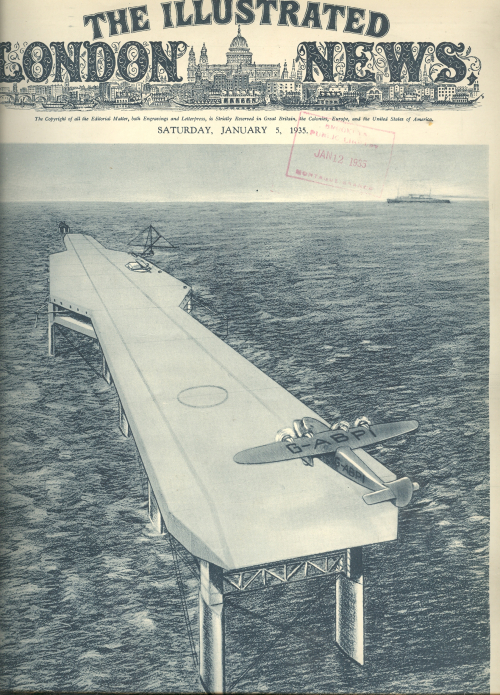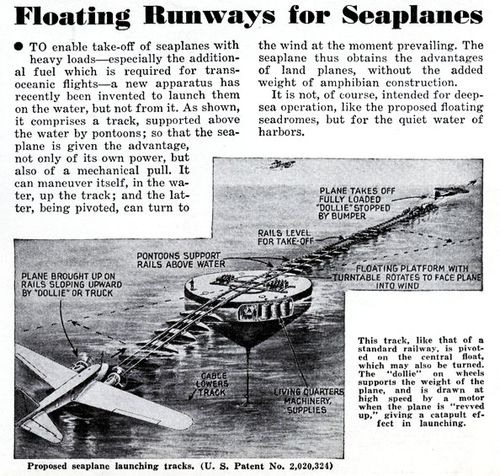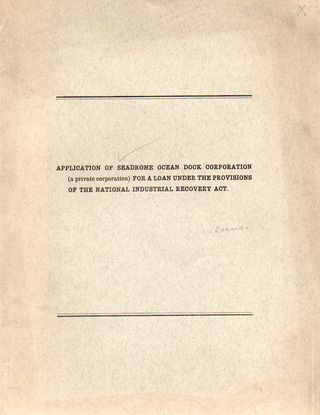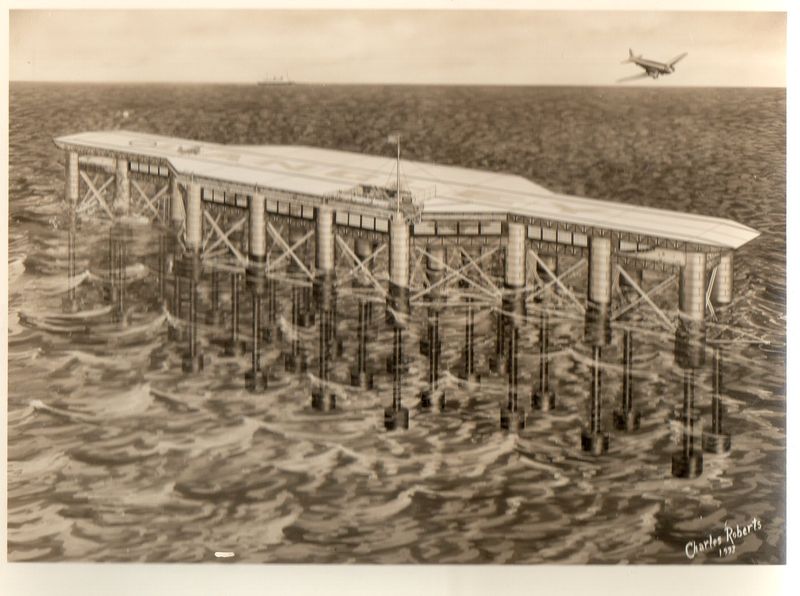ITEM: Application of Seadrome Ocean Dock Corporation (a private corporation) for a Loan Under the Provisions of the National Industrial Recovery Act, printed ca. 1933. 11x8 inches, 34pp. WIth two original photographs one of the floating airports, and a map. This copy come from the White House Library, posted 1933. Printed wrappers. Very nice copy. $500
 Armstrong’s idea would get major play in the popular press from time-to-time, his project renamed “The Seadrome” and discussed as a series of floating islands. Armstrong himself would organize the Seadrome Ocean Dock Corp. in the late 1930’s, his pretty but enormously impractical idea (reported by Time Magazine2 in 1933 as little more than “a perennial gift to Sunday feature editors”) finally grinding to a salty end with greater fuel capacity and efficiency in transatlantic aircraft.
Armstrong’s idea would get major play in the popular press from time-to-time, his project renamed “The Seadrome” and discussed as a series of floating islands. Armstrong himself would organize the Seadrome Ocean Dock Corp. in the late 1930’s, his pretty but enormously impractical idea (reported by Time Magazine2 in 1933 as little more than “a perennial gift to Sunday feature editors”) finally grinding to a salty end with greater fuel capacity and efficiency in transatlantic aircraft. An even worse idea appeared in the pages of Science and Mechanics in 1936:

Notes:
1. A Time Magazine article published 28 October 1929 [a day before the market crashed!] about the Langley oddly states that Langley was the “designer of the plane which, except for accidents, might have flown before the Wrights' plane did in 1903”. Tough potatoes. What the magazine didn’t state was that Langley, who was the president of the Smithsonian Institution at the time with access to major money and benefactors simply went about the flight problem incorrectly, and produced an airplane (or “aerodrome”, as he called it) that did not and would not fly. Not flying because of accidents means, well, not flying. The Wrights’ approach to problem solving was elegant and beat Langley by miles. Langley deserves credit for his other (many) achievements, but not for this aircraft. This same article only references Armstrong as a “swarthy engineer" (the article is reprinted below). The following document, Application of Seadrome Ocean Dock Corporation (a private corporation) for a Loan Under the Provisions of the National Industrial Recovery Act (ca. 1933) asks the federal government for a loan of $30 million (depression) dollars to undertake the construction of the five floating airport transoceanic network. "It will require the work of approximately 10,000 men per month for a period of twenty-four to thirty months". The labor figures did not nclude that necessary to produce all of the material necessary for the project ( for reasons unknown). The palnes would have been to make it across the ocean in 18 to 36 hours.
 The members of the Seadrome Corporation estimated that the entire 30 million would be paid back by 1945, and that the corporation would be completely debt-free. Perhaps all of this made sense when Armstrong first developed the plan in 1913; but even by 1933 it was becoming quite obvious that non-stop transoceanic flight was coming, and coming soon. That would of course make an investment in the Seadrome project superfluous, like building an antique, though an unnecessary one. The first transatlantic non-stop flight was made by John Alcock and Arthur W. Brown in 1919--by the early 1950's jet aircraft would be making the trip with regularity, which means that for most of the life of the completed Seadrome it would have been unnecessary. I feel certain that the Seadrome--which was supposed to be paid off by 1945, though in 1933 there was no inkling on the part of the Corporation members who wrote the request for hte money that a war was looming and that there would have been almost no way for them to have been made at any time betweem 1939 and 1945--would never have been paid for.
The members of the Seadrome Corporation estimated that the entire 30 million would be paid back by 1945, and that the corporation would be completely debt-free. Perhaps all of this made sense when Armstrong first developed the plan in 1913; but even by 1933 it was becoming quite obvious that non-stop transoceanic flight was coming, and coming soon. That would of course make an investment in the Seadrome project superfluous, like building an antique, though an unnecessary one. The first transatlantic non-stop flight was made by John Alcock and Arthur W. Brown in 1919--by the early 1950's jet aircraft would be making the trip with regularity, which means that for most of the life of the completed Seadrome it would have been unnecessary. I feel certain that the Seadrome--which was supposed to be paid off by 1945, though in 1933 there was no inkling on the part of the Corporation members who wrote the request for hte money that a war was looming and that there would have been almost no way for them to have been made at any time betweem 1939 and 1945--would never have been paid for. 



Comments